
It was a challenging, uncertain time when many were looking for guidance, knowing there had to be better days ahead.
It sounds like a brief description of the backdrop for Disney’s 21st animated feature, Robin Hood (celebrating its 50th anniversary this fall), but it could also describe the Disney studio in the 1970s.
During this time following the death of Walt Disney in 1966, the artists who worked closest with him on the studio’s most famous and classic films looked to steer animation forward or, at least, keep it afloat during a very uncertain time.
Walt’s vision touched so many projects for the Company, from film to TV to theme parks, that, without his guidance, many struggled with what to do next.
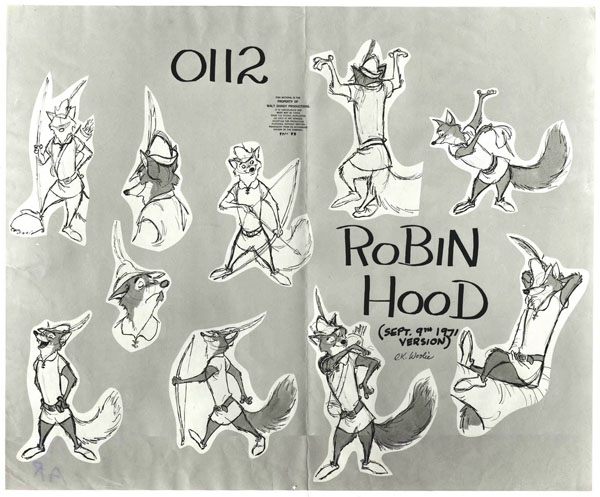
During this time, Robin Hood surfaced as an idea for an animated feature. Disney had already made a film based on the character before with 1952’s live action The Story of Robin Hood and his Merrie Men, but this version would be different.
Directed by Wolfgang Reitherman, Disney’s animated spin on the legend would feature an all-animal cast. It was an idea that, according to author John Grant, in his book, Encyclopedia of Walt Disney’s Animated Characters: From Mickey Mouse to Aladdin, could be “traced back a very long way indeed – right back to the 1930s. Around the time of Snow White, Walt became interested in the possibilities of basing an animated feature on the 12th-century legend (as revamped by Goethe and numerous others) of Reynard the Fox.”
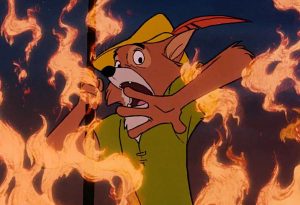 The stories of Reynard focused on the cunning fox who deceives and outsmarts other animals in a kingdom ruled over by a selfish lion.
The stories of Reynard focused on the cunning fox who deceives and outsmarts other animals in a kingdom ruled over by a selfish lion.
Disney legend, artist Ken Anderson worked on Reynard for several years, as did another legend, animator Marc Davis, who created beautiful Reynard character designs featured in Charles Solomon’s 1995 book, The Disney That Never Was.
Unfortunately, Reynard languished at the studio and was never produced. Still, Anderson merged his story and character ideas of a sly fox in a kingdom of animals when Robin Hood was given the “green light” at Disney in the late ‘60s.
Anderson created character design and artwork that would inform the film. The initial idea was to set this version of the famous tale in the deep South, but it was decided to go with the more familiar English Sherwood Forrest backdrop.
Robin and his band of Merry Men (or, as the posters at the time called them, the “Merry Men-agerie!”) attempt to bring happiness back by outwitting the whimpering villain Prince John, who has taxed the “heart and soul out of poor people of Nottingham.”
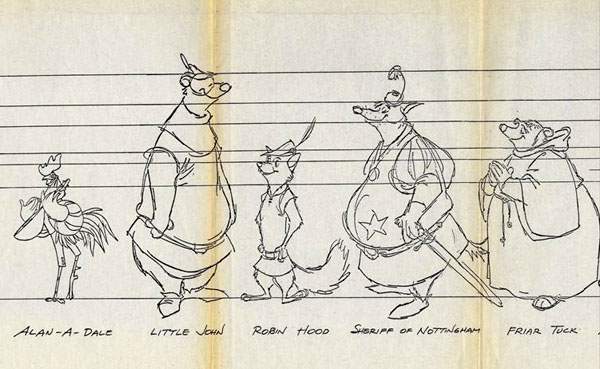
Not only was the cast filled with almost every animal, but almost every popular TV and movie personality at the time, who provided the voices.
Robin Hood the Fox, was noted British actor Brian Bedford after the initial casting of Tommy Steele (who had starred in Disney’s live action The Happiest Millionaire) didn’t pan out. Little John the bear (seeming to be a very distant relative of The Jungle Book’s Baloo) was Disney stalwart Phil Harris; the rooster narrator Alan-a-Dale was popular country and western singer Roger Miller, who also wrote several of the film’s songs; the raspy sidekick of many westerns, Andy Devine gave voice to Friar Tuck, a badger; and actresses Monica Evans and Carole Shelley (who had provided the voices for the geese in The Aristocats) were Maid Marian, a fox and Lady Cluck, a chicken, respectively.
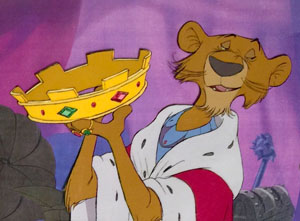 As a triumvirate of standout comedic villains, the twangy-voiced comedian from TV’s Green Acres, Pat Buttram, was the Sheriff of Nottingham, a burly wolf, Oscar winner Peter Ustinov, was brilliant as Prince John, the cowardly lion with British comedian Terry-Thomas as his sidekick, the snake Sir Hiss (and the character was given the comedian’s trademark gap teeth).
As a triumvirate of standout comedic villains, the twangy-voiced comedian from TV’s Green Acres, Pat Buttram, was the Sheriff of Nottingham, a burly wolf, Oscar winner Peter Ustinov, was brilliant as Prince John, the cowardly lion with British comedian Terry-Thomas as his sidekick, the snake Sir Hiss (and the character was given the comedian’s trademark gap teeth).
In their book, The Disney Villain, legendary animators Frank Thomas and Ollie Johnston, who both worked on Robin Hood, wrote about the influence that Ustinov’s vocal performance had on his character:
“The incomparable actor Peter Ustinov created a completely new Prince John who was even more neurotic, but dangerous because he was the ruler and not bright enough for the job.”
During its production, Robin Hood went through a number of changes. Initially, the Sherriff of Nottingham was designed as a goat and looked like a Southern sheriff. An unused version of the film’s finale featured Prince John and Sir Hiss tracking a wounded Robin Hood and even attempting to murder him. There was another deleted sequence where Prince John sends bogus love letters via carrier pigeon to Robin Hood and Main Marion in an effort to trap them. The storyboards of both sequences are available on the Robin Hood extras on Disney+.
The songs in Robin Hood were a mixture of those written by Roger Miller, such as the earworm “Whistle Stop,” as well as “Oo-De-Lally,” and “Not in Nottingham,” as well as Johnny Mercer (of “Moon River” fame) who penned “The Phony King of England” and there was also the Oscar-nominated ballad “Love,” by Floyd Huddleston and George Bruns.
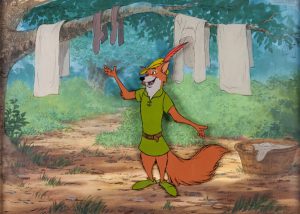 Reportedly, Louis Prima wanted to be part of the cast so badly that he recorded his own album for Disneyland Records entitled “Let’s ‘Hear’ it for Robin Hood,” featuring songs from and inspired by the film. For more on the music of Robin Hood, check out Greg Ehrbar’s 2017 article.
Reportedly, Louis Prima wanted to be part of the cast so badly that he recorded his own album for Disneyland Records entitled “Let’s ‘Hear’ it for Robin Hood,” featuring songs from and inspired by the film. For more on the music of Robin Hood, check out Greg Ehrbar’s 2017 article.
Robin Hood was released on November 8, 1973, with tremendous fanfare. The film opened at New York’s Radio City Music Hall, playing with the famous Christmas Show featuring The Rockettes.
Many critics weren’t kind to the film. Jay Cocks wrote in Time Magazine: “…Robin Hood is only mildly diverting. There is not a single moment of the hilarity or deep, eerie fear that the Disney people used to be able to conjure up or the sort of visual invention that made the early features so memorable.”
Despite this, Robin Hood was a success, with a box-office take that was a Disney record at the time. Also, during its initial release, the film came with a tremendous wave of merchandise, including board games, lunchboxes, comic books, storybook record albums, and more.
In 1984, Robin Hood was the first released film when Disney debuted the “Walt Disney Classics” VHS line, where they looked to begin bringing many of their animated features to home video.
Since then, Robin Hood has become beloved by those who grew up with the film in the 70s and those who watched it repeatedly on VHS.
The film has also inspired a generation of filmmakers, including director Wes Anderson, who included the song “Love” in his stop-motion animated feature, The Fantastic Mr. Fox (2009), and director Byron Howard, who cited Robin Hood as a major influence for his 2016 Disney feature, Zootopia.
Fifty years later, Robin Hood, produced at that uncertain time at Disney and dismissed by a number of critics, has developed quite the audience, and still elicits warm, nostalgic feelings from multiple generations. For many, when it comes to the film, as the main characters themselves might say: “Oo-De-Lally!”


 Michael Lyons is a freelance writer, specializing in film, television, and pop culture. He is the author of the book, Drawn to Greatness: Disney’s Animation Renaissance, which chronicles the amazing growth at the Disney animation studio in the 1990s. In addition to Animation Scoop and Cartoon Research, he has contributed to Remind Magazine, Cinefantastique, Animation World Network and Disney Magazine. He also writes a blog, Screen Saver: A Retro Review of TV Shows and Movies of Yesteryear and his interviews with a number of animation legends have been featured in several volumes of the books, Walt’s People. You can visit Michael’s web site Words From Lyons at:
Michael Lyons is a freelance writer, specializing in film, television, and pop culture. He is the author of the book, Drawn to Greatness: Disney’s Animation Renaissance, which chronicles the amazing growth at the Disney animation studio in the 1990s. In addition to Animation Scoop and Cartoon Research, he has contributed to Remind Magazine, Cinefantastique, Animation World Network and Disney Magazine. He also writes a blog, Screen Saver: A Retro Review of TV Shows and Movies of Yesteryear and his interviews with a number of animation legends have been featured in several volumes of the books, Walt’s People. You can visit Michael’s web site Words From Lyons at: 






















Before physical releases, as rentals were ceased. Altogether, I had the opportunity to rent “Robin Hood“. I didn’t think it was as bad as people said it was. In fact, I would buy an addition of this film, if it were re-issued on physical media from the Disney company with some special features. Perhaps having those special features as seen on Disney+ on physical media would definitely, be worthwhile!
Now, I’ll be brief, but there is a big 100th anniversary edition coming out on Blu-ray late this month called “Disney, animated, film collection“, and “Robin Hood“ will be part of that. That’s the only way I could buy it, if I wanted to buy it. I still might take the plunge, but wow, what an expensive way to get a few films. Anyway, thanks for this great article.
Look around at various online retailers. Robin Hood has never been put back in the vault, so to speak. A new steel book Blu-ray was released just last year and had a Walmart retailer exclusive edition as well. It’s always been available and continues to do so at an extremely reasonable price compared to many other contemporary features.
Note: My computer seems to have taken it upon itself to delete the comment I just wrote, so just in case, here it goes again:
Robin Hood was also marketed as the culminating event of the “50 Happy Years” celebration. As I have mentioned in other posts, 1973 was a banner year to be a Disney fan. The 50-year celebration was presented with a lot more fanfare than the current 100-year celebration has thus far generated. The film was also released at the optimal time of year, Christmas time. What better time to release a Disney film than when its target audience is out of school and available to attend daytime showings?
There was also a great book released that year: “The Art of Walt Disney”. by Christopher Finch, a huge art book filled with photos and stills from Disney productions, plus a narrative that covered the highlights of Disney’s career. It featured an entire chapter on the making of Robin Hood. Retailing at the then-whopping price of forty dollars! I found that book under the tree on Christmas morning. Plus, shortly afterward I received Leonard Maltin’s then-comprehensive book “The Disney Films” as a New Year’s/birthday gift.
There were also four comic book albums, specially. bound, that included not only the movie story but further adventures of Robin Hood and his Merry Menagerie. Plus the Disneyland Storyteller album as well as other records including the above=mentioned Louis Prima release.
Today the Disney company is interested in profits much more than quality of their product, and it shows. Back in 1973, the magic of Disney was still magical!
It’s annoying to write a comment that disappears into cyberspace before you have a chance to post it. If it happens again, just right-click on the empty comment box, then left-click “Undo”. That will restore the deleted text. It took me a while to figure it out.
Thanks, Paul!
Interesting, thanks. I have that book, but I believe this is the first time I’ve heard that there was a big publicity campaign for the 50th anniversary of Disney.
Correct, Frederick. I remember the records and publicity fopr tha, and saw it, too, in the 1973 release….with all their Jungle Book looks! They cast Phil Harris as a Baloo like Little John, but got a smaller snake than Kaa (Sterling Holloway) with Terry-Thomas voice for the insecure Prince John (Peter Ustinov, also the voice of King Richard!!)’s assistant. Generally, country-southern voices..Phil as Little John, Roger Miller narrating (from the original tale..both Cat Ballou, There’s Something about Mary and Babe series would later use this device), & Andy Devine as Friar Tucker on the good guy side, and Pat Buttram as the Sherriff of Nottingham, George Lindsey as Trigger & Ken Curtis as Nutsey (the only one not credited in the ads of the Disneyland records), on the villians, when it came to the western voices…not to mention other dialects used.
Steve C.
I also had mentioned in the comment that my computer deleted, that when I saw the Robin Hood movie in our local theatre, it was on a special showing that tied in with the “50 Happy Years” celebration and included on the same bill, the classic Mickey Mouse cartoon “Mr. Mouse Takes a Trip” plus a sneak preview of the soon to be released live-action comedy “Super Dad.” White the latter did not set the box office on fire, it did serve to underscore what Disney’s forte had always been–animation. Robin Hood was not tarnished by being preceded by a less than stellar live action film. And regardless, it was still exciting to see a film ahead of its general release. And it made the Robin Hood film even more significant to be part of this 50th anniversary tie-in.
And as regards the Christmas marketing of the film, it was “officially” introduced by Jimmy Cricket on a fresh edition of “From All of Us to All of You” just a day or so before Christmas. That was when Christmastime and Disney both really meant something to kids.
Robin Hood has, from the moment of its release, been one of Disney’s most maligned animated features, and objectively I’d be hard pressed to argue against many of the criticisms leveled against it: yes, it’s episodic; yes, the reuse of animation is sporadically distracting; yes, it lacks the deeply-affecting moments of previous Disney classics. And yet, I enjoy the film all the same. The vocal performances are top notch across the board, the character animation is terrific, the designs are appealing, and the bare bones of the Robin Hood legend are sturdy enough to support quite a bit of tweaking and embellishment. Objectively, I’d have to agree that Robin Hood is in the bottom half of the Disney animated canon; subjectively, though, I’d rather watch it than several of the more highly-regarded films.
One more quick note about the film: Monica Evans (Marian) and Carole Shelley (Kluck) first rose to prominence in the US for playing the Pigeon sisters in The Odd Couple, being the only actors to appear in the same roles in the original play, the 1968 film, and the TV series.
(And yes, I know Disney recently announced a “live action” (read: mo-cap) remake of this film; I’m… not optimistic about its prospects.)
“Robin Hood” was my favorite movie when I was a kid. I watched it all the time. It’s still one of my all-time favorite movies. I love the voices (especially Peter Ustinov as Prince John), the animation, Ken Anderson’s designs and George Bruns’ score. I understand why this movie has gotten a bad rap, but I’m happy to see that there are so many people besides myself who love this movie. Overall, “Robin Hood” is a fun movie.
Found this on Blu-ray at my nearby Wally World a few years ago marked down to seven bucks–To quote an old Eddie Murphy routine, “What a bargain!”
They’re really pushing the celebrity voice cast in that trailer, just like they do in the opening credits– A harbinger of animated feature promotion to come, unfortunately (And they won’t even have the jovial, booming tones of Dick Tufeld to make it go down easier).
“Robin Hood” isn’t bad, it’s just uninspired, using, as Charles Solomon says in “Enchanted Drawings,” the Saturday morning device of making the characters animals for no particular reason. Musically it’s all over the place; there’s no uniform style. As catchphrases go, “Oo-da-lolly” is too unwieldy to catch on for the kids. The “child” characters with lisping child voices anticipate Don Bluth cutesiness. And it was one Phil Harris happy-go-lucky character too many. Speaking of voices, Brian Bedford was a much better choice for Robin than Tommy Steele (who’d have made Robin sound too boyish).
Still, it was released at a time when new Disney animated features were major events because they came out one every few years (as opposed to the current practice of grinding them out like sausages), and the passing years have given it time to creep into even more hearts as a “classic.” And it’s more fun than “Aristocats.”
Grinding out like sausage? I seemed to recall that Walt was planning to do an animated feature film per year in the first place but circumstances such as the war put the idea in the backseat then.
Perhaps, but that still would have diminished the impact of the product, and possibly the product itself: quantity as opposed to quality.
The cut ending should have been in the movie. Would actually make John a villain, instead of a joke.
Like many kids of my generation, I enjoyed Robin Hood a lot. But when I started watching it alongside earlier films like The Jungle Book, I found it underwhelming in terms of story and atmosphere. I still enjoyable for its characters, but definitely not as strong as the films that were made with Walt’s involvement.
Im glad that Didier Ghez went into further detail on the production of this film in the They Drew As They Pleased series. Despite being a lesser film, the production story should be told.
I wondered who did the voices for the two buzzards, so I looked it up on IMDB. Turns out they were none other than George “Goober” Lindsey and Ken Curtis from Gunsmoke!
I was surprised to read that this film was not particularly well-received at the time of release, and still is listed by folks as in the bottom 50% of Disney films. It’s easily my favourite Disney film. (I’m not much of a connoisseur though. I just like what I like.)
It startles my students when I inform them that Prince John’s line “Mother always did like Richard best” is historically accurate. Yet so it is. Eleanor of Aquitaine made no secret of who her favorite son was.
But one strange historical inaccuracy occurs in the song lyrics to “the Phony King of England”. The lyric states “Too late to be known as John the First, he’s sure to be known as John the worst.” This is not true. He wasn’t too late. There hadn’t been a King John in England up to that time. But there never was another King John after him, because of his poor reputation and misdeeds. A more accurate lyric, and one that would keep the rhyme scheme, could have been: “He’ll never be known as John the First, he’ll only be known as John the Worst”. Of course that is forecasting a certain historical perspective that people of the time wouldn’t have had, but it would be more accurate. When I was a child, this didn’t bother me, because I didn’t know that much about English history. But once I learned about the Plantagenet Kings, it bugged me big-time. Now it’s hard to listen to that song because of the glaring historical error.
The line may be historically accurate, but it also evokes a running joke in the Smothers Brothers’ act, when Tom would tell Dick (i.e., Richard), “Mom always liked you best.”
I remember seeing this in a theater (also getting “The Art of Walt Disney” as a gift). While there were plenty of nifty characters and gags, it felt like it didn’t have a beginning or an end. We join the story in progress, with all the characters and relationships already in place. Then we jump to an epilogue with King Richard returned, Robin and Marian married, and villains on the rock pile.
Yes, everybody knows the basic legend. But we still want to SEE how Robin became an outlaw, and his quarterstaff battle with Little John, and maybe how he met Maid Marian. Every version has its own take: Disney’s live action had a young, common-born archer avenging his father’s murder; he and Marian were childhood sweethearts. Errol Flynn was a nobleman who took up the longbow; haughty Marian had to be convinced his cause is just. Douglas Fairbanks Sr., one of Richard’s trusted crusaders, was almost a schoolboy: brave, cocky, and terrified of pretty girls until he meet Marian.
This was always a favorite of mine. I always thought it combined the elements that made Reitherman’s animation so good: action and comedy. I hope someday somebody will do justice to his films. “Ah-ha! Ah-ha!”
Disney’s “Robin Hood”, is of course, the first choice of furry fandom. I used to know a rather eccentric fellow who always told me what format his latest copy of “Robin Hood” was, he started with VHS, then a 16mm print, then a laser disc, then finally a 35mm Technicolor print! The re-use of the same walking scene of Little John coming toward the camera really bothered me, it looked like a Hanna-Barbera shortcut. Also, Woolie’s re-use of some of the “Silly Song” sequence from “Snow White and the Seven Dwarfs” with the Robin Hood characters traced over it, was the cheapest of the cheap. Woolie used to direct his features by going over the scenes about to be handed out, and asking “Who have we got that can animate this?”. If he couldn’t think of anyone, he threw out the scene and went on to the next one. It’s a miracle under the circumstances that “Robin Hood” made any sense at all. I enjoy hunting for Milt Kahl’s scenes, they almost make looking at “Robin Hood” worthwhile.
I admit I do wonder how the film would’ve turn out under Walt’s supervision. According to Frank Thomas and Ollie Johnson in their final book “The Disney Villains”, they mentioned what they considered the main problem of the film which I mainly agree with: They felt like the title character was too “invincible”.
That being said, I did like the chemistry with Prince John and Sir Hiss and makes me wish Peter Ustinov and Terry-Thomas did another movie together.
I just noticed the “O.K. Woolie” on that Robin Hood model sheet. I guess he really did run everything, since that woyuld’ve been “O.K. J.G.” thirty years before.
Considering the state of animation in the 1970s as a whole, let alone at Disney even, Robin Hood looked Shakespearean in comparison.
But yes, even I have to admit that the film wasn’t among Disney’s best overall (even though I still quite liked it), they definitely should have gone with this ending as it gave better closure than what we actually got: https://www.youtube.com/watch?v=tA-ZeYxCJPM
Funny how it just occurred to me that making Robin a fox rips off the first official UPA cartoon “Robin Hoodlum” (starring Fox and Crow).